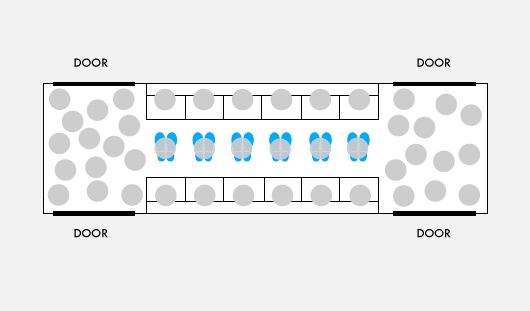Tube carriage behavioural economics

A Labs Blueprint that aims to end the dreaded cry of ‘Can you move down please?’
Schiphol Airport had a wee little problem. Or a little wee problem.
Visitors to the men’s loos, presumably overly excited to be in Amsterdam, were wildly misfiring when they used the urinal.
Clearly there were a number of solutions to the problem: splashback screens that let urine in but not out, rubber floor mats, curiously shaped urinals in which the stream ricochets off concave walls into rather than out of the urinal, a polite sign asking the blokes to try harder.
But Jos van Bedaf, manager of the cleaning department at the airport, had a simpler idea. Print a small picture of a fly in the urinal and guys will, subconsciously or not, aim for the fly – helping them to hit the right spot.
It worked; ‘spillage’ went down by 80% which led to a 20% reduction in cleaning costs. But more importantly, it meant a much nicer welcome to Schiphol airport than before.
Behavioural scientists call this a nudge (or nudge theory) – a small creative solution to a problem that subconsciously changes behaviour. It’s these small, seemingly trivial interventions to big problems that Rory Sutherland says is where agencies can add the real value to clients in the future.
Big problems with small solutions are everywhere. We ourselves recently tackled the problem of rubbish outside our front door with a simple sign. The results were astonishing (and refreshingly clean).
It got me thinking about a big problem London faces on a daily basis: overcrowding on the tube, and what could be a simple solution.
While there is clearly the need in the long term for a vast infrastructure change to help fit more people on the underground, in the meantime there needs to be a better way to get passengers to do the one task that is tediously shouted in my ear every morning:
‘Can you move down please!!?’
So, how about trying this little nudge?
If TFL printed a set of footprints down the tube carriage in between the seats, subconsciously (or consciously) people would stand on them. It would mean you could nudge people to stand closer together, in an orderly way and free up more space on the tube. A bit like this:

As Rory says with many of the small solutions he suggests, you can never be truly sure if it will work but it would be so cost efficient and simply to test, if even on one train on one line, why would Transport for London not give it a go?
If anyone from Transport for London is listening, please do get in touch (or say hello in the comments) and we can help people get nudged on the tube, in the right way.
